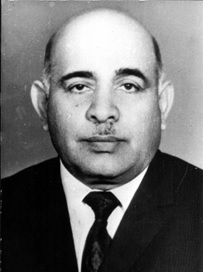
Hasan Ali oglu Seyidov was born in 1910 in Iravan. His birth date was mistakenly written as 1906 on his birth certificate. In 1918, he went to the first grade in Korpübulag neighborhood in Iravan, and because of the situation created as a result of the massacres conducted by Armenians, he came with his family to Igdir, Kagızman, and then to Kars. His father died of pneumonia in Kars. Under the protection of his uncle, he first came to Tbilisi and then to Ganja. In 1921, he returned to Tiflis and studied at the five-year Anjuman school.
In 1925, Hasan Seyidov, who finished the 7th grade in the school No. 97 and came to Baku, studied here in the 2nd year of the workers’ school. After graduating, he started studying at school No. 18 and graduated in 1928. In the fall of the same year, he entered the Faculty of Agriculture of the Azerbaijan Polytechnic Institute and graduated in 1931. First, he was sent to Vartashen (Oghuz) district as an agronomist, and after working there for a while, he was sent to Moscow for post-graduate studies together with a group of Azerbaijani agricultural specialists. There, he worked as a graduate student at the All-Union Institute of Fertilization and Soil Science, and in April 1934 he returned to Baku as the first Azerbaijani candidate of sciences in agriculture after defending his dissertation on “Potassium leaching in soils”. During his postgraduate studies, he headed the Encyclopedia of Soil Science in the Nizhny-Novgorod region of Tatarstan for one year.
In 1937, at the height of the repression, Hasan Seyidov was appointed the director of the Azerbaijan Cotton Growing Institute. On June 22, 1941, a week after the beginning of the Great Patriotic War, he was entrusted with the leadership of the Azerbaijan Agricultural Institute. In 1942, he was appointed the chairman of the Ganja City Executive Committee, and in May 1943, he was sent to the position of head of the agricultural department of the Central Committee of Azerbaijan.
On April 1, 1944, Hasan Seyidov was approved as the third secretary of the Central Committee of the Communist Party of Azerbaijan, and in January 1946, he was elected the second secretary of the Central Committee. He worked in that position until June 1950, and then he was appointed as the first deputy chairman of the Council of Ministers of the Azerbaijan SSR. After working for a year, he was sent to Moscow for a special one-year course of the Central Committee. In April 1952, he was appointed the chairman of the Baku Province Executive Committee, and after the abolition of Baku and Ganja provinces in 1953, he worked as the chairman of the State Planning Commission. A year later, he was appointed as the Minister of Agriculture of the Azerbaijan SSR and worked in that position until 1959.
In 1959, Hasan Seyidov was transferred to the position of permanent representative of the Council of Ministers of the Azerbaijan SSR to the Council of Ministers of the USSR, and in 1960–1961 he worked as the director of the Scientific Research Institute of Cotton Growing. For 2 and a half years, he worked as the deputy chairman of the State Planning Committee of the Republic. Until 1970, he worked as the chairman of the State Vegetable and Fruit Production Committee.
Hasan Seyidov retired in 1970 and in 1972 defended his doctoral dissertation on the topic “On the development of vegetable growing in the republic” and was awarded the title of professor. Since 1972, he worked as the head of the technical department and the chairman of the technical council at the Azerbaijan State Construction Project Institute. He was the author of up to 70 scientific works. He was elected a deputy of the Supreme Soviet of the USSR four times (II, III, IV, V convocation), worked as the chairman of the economic commission of the Chamber of Nations of the Supreme Soviet of the USSR. He was a deputy of the Supreme Soviet of the Azerbaijan SSR for three terms. He was a member of the Central Committee of Azerbaijan and the bureau of the Central Committee for 10 years.
Hasan Seyidov died on June 8, 1999. He was buried in II Alley of Honor.



